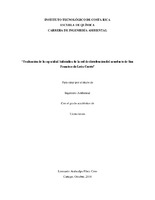Mostrar el registro sencillo del ítem
Evaluación de la capacidad hidráulica de la red de distribución del acueducto de San Francisco de León Cortés
| dc.contributor.author | Pérez-Coto, Leonardo Atahualpa | |
| dc.date.accessioned | 2017-09-12T17:11:00Z | |
| dc.date.available | 2017-09-12T17:11:00Z | |
| dc.date.issued | 2016 | |
| dc.identifier.uri | https://hdl.handle.net/2238/7390 | |
| dc.description | Proyecto de Graduación (Licenciatura en Ingeniería Ambiental) Instituto Tecnológico de Costa Rica, Escuela de Química, 2016. | es |
| dc.description.abstract | Today, increasing demand on water supply services requires service providers to assess the hydraulic capacity in order to determine the feasibility of adopting new water services. However, this assessment requires technical information system that sometimes the WDS do not have or have it with a very poor precission, and the use of computer models are not usually calibrated so that the results are invalid. In that sense, this research looked at the evaluation of the hydraulic capacity of the supply system administered by the San Francisco ASADA in order to demonstrate the proper use of computer models for these purposes, seeking the hydraulic system efficiency in the framework of integrated water resource management. Initially, gathering information (network and users cadastre) was performed. In addition, an analysis of the current and future demand in the aqueduct was made, the model was built in EPANET and proceeded to a macro-calibration to determine the goodness of fit of the model trough objective functions, in a scenario of maximum hourly demand during the dry season, when the coffee harvest occurs in the area. It was found that the demand of the population is 127,4 Lpd in a system capable of withstanding approximately 1.43 times the current demand of 1,13 L/s, until 1,62 L/s, having the possibility of supply about 185 new users. However, this capacity is subject to water supply water sources which currently offers 4,54 L/s and the impact on water quality and hydrometric districts in the network due to the adoption of new water services. Although this study only provides a macro-calibration, there is information to provide recommendations for the management of the aqueduct, and the necessary inputs are provided to carry out a comprehensive study of calibration, thus strengthening the understanding of the use of computer models to evaluate the hydraulic capacity of water supply systems in Costa Rica. | es |
| dc.language.iso | spa | es |
| dc.publisher | Instituto Tecnológico de Costa Rica | es |
| dc.rights | acceso abierto | es |
| dc.subject | Red de distribución agua potable | es |
| dc.subject | Capacidad hidráulica | es |
| dc.subject | Modelación estática | es |
| dc.subject | Servicios de abastecimiento de agua | es |
| dc.title | Evaluación de la capacidad hidráulica de la red de distribución del acueducto de San Francisco de León Cortés | es |
| dc.type | proyecto fin de carrera | es |


